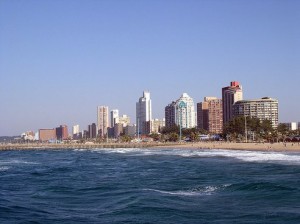Article Written by Brian Merchant
Every year, the U.N. gathers negotiators and world leaders to attempt to craft a global framework for reducing worldwide greenhouse gas emissions. Every year (with the exception of Kyoto in 1997), they fail. Even so, given all of the noise and pomp leading up to the 15th Conference of the Parties (COP15) in Copenhagen two years ago, it’s hard to believe that COP17 in Durban is even the same meeting.
Sure, there were a few obligatory newspaper stories about the proceedings buried on A17 or so, and some coverage on green blogs like this one, but some 99% of Americans will have no idea there is or ever was an international conference underway in Durban, South Africa. But it kind of seems important, doesn’t it? I mean, just read the lede from the New York Times’ story on COP17: “With intensifying climate disasters and global economic turmoil as the backdrop, delegates from 194 nations will gather in Durban, South Africa, starting Monday to try to advance, if only incrementally, the world’s response to dangerous climate change.”
And the world’s response thus far has been limited, at best. Japan, the European Union and a number of developing nations have made solid process by ratifying the Kyoto Protocol and reducing emissions since then. But the world’s biggest polluters, the United States and China, remain largely intransigent.
The Times’ report notes that “the conflicts and controversies to be taken up in Durban are monotonously familiar: the differing obligations of industrialized and developing nations, the question of who will pay to help poor nations adapt, the urgency of protecting tropical forests, the need to rapidly develop and deploy clean energy technology.”
In other words, these climate negotiations will hit most of the same roadblocks that they have before, year after year. Which is why, after the grand deflation of the world’s hopes for a comprehensive climate treaty at Copenhagen, potential progress is inevitably described as “incremental”. At COP16 in Cancun last year, for example, a mechanism was established to help deliver funds from wealthy nations to poor ones for carbon reduction and forest preservaton projects.
So what’s on the table for this year? Not much, really. The biggest question involves what to do with the now 14-year-old Kyoto treaty. Right now, it only covers a measly 1/3rd of the world’s carbon emissions (due primarily to the omission of India, Brazil, China and the U.S., which never signed), according to the Washington Post. An initiative is expected to extend Kyoto 5 more years, but countries like Japan, Canada and Russia are now saying they won’t play ball unless the U.S. and developing giants like China do, too.
In addition to Kyoto wrangling, WaPo reports that the other top goals of the conference are largely technocratic: “Delegates to the U.N. Framework Convention on Climate Change will focus largely on technical details, such as how to administer a future fund to help poor nations adapt to global warming and how to transfer clean technology to developed nations.” Which drives home once again: Don’t even think about getting your hopes of for anything resembling a global climate agreement. As for us, Todd Stern, the lead U.S. climate negotiator, is talking a lot about nations “vigorously” working to cut emissions at home — a euphemism for “sorry, we’ve got nothing.”
And that’s what this meeting will highlight, more than anything: The failure of the world’s largest economies to act on mitigating climate change, even in the face of “climate disasters” and more evidence than ever that human activity is causing the planet to warm.








